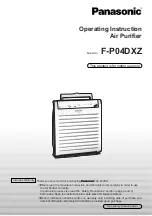
5
Unitary Products Group
Each coil has an orifice installed in the fitting between the
liquid line connection and distributor. The orifice is identi-
fied on a label next to the liquid line connection.
The orifice shipped with the outdoor unit is based on the
“most sold” combination, but it may be changed, depend-
ing on the capacity and efficiency of the outdoor unit,
elevation differences, and/or long total line lengths. An
additional orifice(s) is shipped with most outdoor units for
the most commonly required replacement combinations.
Other sizes must be ordered from Source 1 Parts if re-
quired.
See the appropriate Tabular Data Sheet for the correct
orifice size and charge adder. If the orifice size matches,
nothing further is required and the refrigerant lines may
be connected per the outdoor unit instruction. However, if
another orifice should be used, see the coil instruction for
details to change the orifice in the coil.
OPENING BASE VALVES
All models in this series have brass service valves. These
valves are not back seating. Opening or closing valve
does not close service port. Service ports have Schrader
valves for gauge connections. Use back–up wrench on
valve body when removing cap to open or close the valve.
To open, insert hex wrench into stem and back out count-
er clockwise until stem just touches retaining ring.
If the valve stem is backed out beyond the retaining
ring, system pressure could force the stem out of the
valve body and possibly cause personal injury. In
the event that the retaining ring is missing do not at-
tempt to open the valve.
All caps must be replaced to prevent leaks.
Some units may have factory installed 1–1/8” ball valves.
To open the valve, remove the brass valve stem cap, lo-
cated on the side of the valve, with an adjustable wrench.
Next, turn the valve stem 1/4 turn CCW (away from unit).
Replace valve cap finger tight, then tighten an additional
1/6 of a turn with a wrench, using a back–up wrench on
the valve body.
OIL TRAPPING
When the outdoor unit is above the indoor coil oil trapping
is necessary. Please refer to APPLICATION DATA,
690.01–AD1V (1296) and worksheet 690.01–AD1.1V
(791) “General Piping Recommendations and Refriger-
ant Line length”.
Check the system for correct charge after all components
of the system have been installed, connected and wired
correctly.
Connect service gauges to low pressure port and dis-
charge service ports.
Allow unit to operate until system pressures and temper-
atures have stabilized, making sure that the pressure and
temperature align with unit service data. If not, check sys-
tem charge and adjust if necessary.
ELECTRICAL WIRING
To prevent electrical shock, open remote discon-
nect so electrical supply to outdoor unit is shut off.
Contactor does not open both sides of the 208/230
or 460 volt electrical circuit.
POWER SUPPLY
All wiring must comply with N.E.C. and local codes. See
rating plate and product data sheet for volts, frequency,
phase, maximum fuse size and minimum branch circuit
ampacity. Refer to the wiring diagram inside the unit con-
trol box cover before connecting to power supply.
1.
The line voltage service wiring for the outdoor unit
must include a disconnect switch located within sight
of the outdoor unit.
2.
Use the correct size fuse or circuit breaker as listed
on the unit rating plate and data sheet. See Tabular
Data Sheet for minimum recommended wire size. If
using nonmetallic–sheathed cable (NM or NM–B)
ampacities shall be that of 60º C conductors per
N.E.C. 336–26.
3.
Wiring connections. — Two are provided in the con-
trol box:
a.
One for low voltage wiring.
b.
One entrance for high voltage.
The reversible High Voltage Conduit Plate is factory
installed for 1/2” conduit connections. For 3/4” conduit,
remove the screw holding the plate in place and reverse
the location of the holes. For 1” conduit, remove the con-
duit plate and discard. Re–install screw to maintain the
integrity of the unit structure, regardless of the conduit
being used. See Figure 3.
4.
Power connection to the unit is facilitated by screw
terminals on the outdoor unit contactor. See Figure 3.
5.
Ground the outdoor unit using the ground lug pro-
vided. Unless the outdoor unit is grounded through
proper wiring to the service entrance ground, a suit-
able separate ground should be provided at the out-
door unit.
Casing or cabinet must be permanently grounded in
accordance with National Electric Code or other ap-
plicable local codes.


























